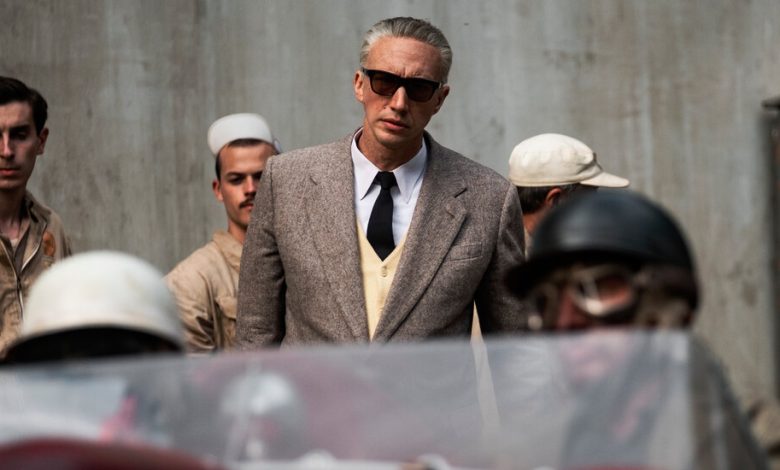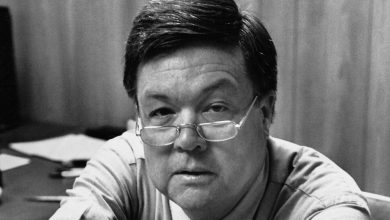‘Ferrari’ and ‘The Killer’: 1 Cinematographer, 2 Very Different Looks

Michael Mann’s new drama “Ferrari,” about several important weeks in the life of the racecar driver and manufacturer Enzo Ferrari, is many things: biographical drama, thriller, period costume film, and also a story about business rivalries, domestic disputes and personal grief. Adam Driver plays the automotive magnate as a man divided between his obsessive pursuit of professional glory and his straining responsibilities as a husband and father. Accordingly Mann approaches these two worlds with different, even diametrically opposed styles. There are intense, breakneck racing sequences and dark, elegiac domestic scenes, and little in between.
“There’s really two distinct aesthetic sensibilities in the film,” Erik Messerschmidt, the film’s director of photography, said in a recent interview. “Michael wanted the interpersonal drama parts of the film to be more classically made than the racing.”
Messerschmidt said that for the heavier moments Mann “wanted to reference Italian Renaissance paintings,” with their pronounced shadows and dense compositions; the racing scenes, by contrast, made use of cutting-edge technology and contemporary techniques.
Messerschmidt also served as the cinematographer on “The Killer,” David Fincher’s recent thriller about a hit man dealing with the fallout of a job gone wrong, now streaming on Netflix. Looking at the two films side by side reveals the marked contrasts in the directors’ approach.
“Their use of the camera, in particular, is very different,” Messerschmidt said. “Michael is often looking for those spontaneous moments, and I think he’s a little more shoot-from-the-hip than David is. Whereas David is a very precise, methodical filmmaker — he’s one of a kind that way.”
Here, Messerschmidt explains how the look of “Ferrari” was achieved on and off the track and how it compared with his work on “The Killer.”
Vintage Speed
“Ferrari” opens with a brisk montage of grainy black-and-white newsreel footage that shows Enzo in his youth racing for Alfa Romeo. Mann, who had been trying to make “Ferrari” since the early 2000s, spent a lot of time poring over archival footage of motor racing from this era, and he and the crew watched it often to help faithfully capture the look. While shooting an early racing sequence, Mann had the idea to open with Enzo himself on the track, to remind the audience that he used to be racer.
The scene is “a combination of actual archival footage and visual-effects compositions of Adam driving a period-correct racecar from the ’20s,” Messerschmidt explained. Driver had to actually get on the track: it’s not a sound stage or a green screen but footage of him that’s been rotoscoped, which accounts for why this shot looks so realistic.
By contrast, Messerschmidt and Fincher spent a lot of time adjusting images for “The Killer” in postproduction to hone the look of key locations in Paris, the Dominican Republic and Chicago, which they wanted to differentiate aesthetically.: “All of those places have a unique look, in terms of architecture, design and how the light falls,” the cinematographer said. Paris, for instance, was depicted with “this kind of split-tone color palette of cool shadows and warm highlights.”
While each location had its own visual identity, Messerschmidt said he was conscious of “still keeping them within one cohesive world,” adding, “I didn’t want it to feel like a ransom note of color palettes,” he joked.
Racing Along
The second half of “Ferrari” focuses on his efforts to win the 1957 Mille Miglia, a wildly competitive race that covers almost 1,000 miles on public roads. To capture its blistering intensity, Mann got extremely close to the vehicles, as in this shot of two cars speeding neck and neck on a winding mountain overpass. The camera team, Messerschmidt said, was following just behind in a Porsche Cayenne. “We were driving these cars at the actual speeds,” Messerschmidt said. “Michael was not interested in faking it or undercranking the camera.”
As in this shot, many of the driving scenes have a rawness that emphasizes just how fast and dangerous the racing is. The style, Messerschmidt said, “has a very vérité feel to it,” which adds to the sensation of raw power. “These cars are visceral, they are loud, and the engines shake, and the suspension is stiff. That was something we wanted to show from very beginning.”
Night Drive
Part of the Mille Miglia race takes place on an open stretch of road in the dead of night. The only sources of light are the cars’ headlights, which illuminate the rain-slick road and reflect off one another. Shooting this sequence without conventional movie lighting, Messerschmidt said, was a matter of necessity, because there was no obvious place to put up lights. “I had a lot of anxiety about that scene,” he said. “I didn’t really know what I was going to do.”
Eventually, he said, he “decided to roll the dice and just do it with the headlights.”
“The Killer” makes striking use of nighttime as well, in part because the movie is about a man who “lives and lurks in the shadows,” Messerschmidt said. “We wanted to work in this murky world. It felt like an appropriate thing to lean into that in the film.”
Up Close and Personal
When “Ferrari” is not on the track, the camera has a tendency to probe the characters closely, sometimes getting right up in their faces. In this sequence on the factory grounds, the lens gets so near Enzo that his features become almost a blur. “When Michael really wants to get the audience into a character and bring you close, he will put you literally close to the actor,” Messerschmidt said.
To achieve this “very odd point of view,” Messerschmidt employed a “skater scope,” which extends the lens about 10 inches from the body of the camera. That extension “means we can get very close to the actor without the Steadicam itself hitting the actor’s knees,” he explained.
Fincher also wants to use the camera to understand his characters in “The Killer,” but “the camera has no personality in the way that Michael’s camera does,” Messerschmidt explained. “Ferrari” has “a very subjective camera,” while Fincher “is working with a conversation between subjectivity and objectivity.” The camera “reinforces” the unnamed executioner played by Michael Fassbender.
This is clear in the many precise frames and symmetrical compositions — an aesthetic that mirrors the hit man’s meticulousness. “When the killer is in control and confident, the camera is extremely confident, in terms of how we operate it and how the shots cut together,” Messerschmidt said. “When the killer loses control and starts to fall apart, the camera falls apart as well.”
Memories at Sunset
A centerpiece of “Ferrari” takes place at an opera, where Enzo has an intense emotional reaction. Mourning the loss of his son, he thinks back to their time together, as the film cuts to brief, gauzy flashbacks, including this one, in which the two are playing in a field. The camera is very low to the ground, and the sun is just setting over the horizon; the delicate style is reminiscent of the work of Terrence Malick.
“I think I get now maybe how Malick works,” Messerschmidt said. For this flashback, he and Mann started “working with the actors and the camera, improvising a bit,” he said, adding that they just happened to catch this interaction. “It was very spur of the moment. It wasn’t previsualized.”
Small and Agile
At times during the racing sequences in “Ferrari,” the camera is fixed to the body of the car itself, stuck alongside as the vehicle zooms at extraordinary speeds. In this shot, we see the bold Ferrari logo against a whooshing blur of grass and road. Because they were sticking a camera onto a car that was pushing its technical limits, “we had to be very conscious of weight distribution and aerodynamics,” Messerschmidt said. Their choice for these shots was a Red Komodo camera, “which is about the size of a Rubik’s Cube.” As Messerschmidt noted, “This would have been a very challenging film to make with a large, cumbersome motion picture camera.”




